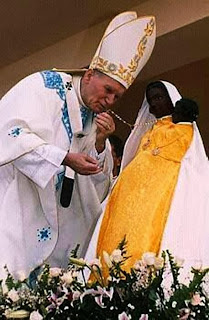Black Madonna
The Power of the Black Madonna
(Pope John Paul II with Black Madonna, September, 1995; Photo from larry’slibrary
I chose Fr. Richard Rohr O.F.M.’s March 17, 2022 Meditation below for this post to contrast the power of whiteness prevalent within much of modern Christianity. This power is demonstrated in the dominant culture’s portrayal of Jesus and His mother Mary (the Madonna) as typically white, European when per the Biblical naratives they were born in the Middle East and no doubt were much darker skinned.
The meditation is as follows:
“Scholar and activist Christena Cleveland has studied and visited Black Madonnas across France. She writes of her pilgrimage to a 12th-century Black Madonna in the French town Mauriac and the transformative impact this encounter had on her:
As I examined the cavernous interior [of the basilica], I was aggressively confronted with signs forbidding visitors from trespassing beyond the crimson velvet ropes surrounding the town’s renowned sixth-century statue of the Black Madonna, an uncommon dark-skinned version of the Virgin Mary. . . . The ropes hung more than forty feet from the magnificent unapologetically Black-and-female Madonna.
My unapologetically Black-and-female body longed to be near this Black Madonna, whom people of diverse races, religions, and eras have recognized as a Black and female image of God. Though I was raised in a Black family and had spent significant time in Black church spaces, the image of a white male God permeated my being. I know I am not alone. The late Black tennis star Arthur Ashe shared his childhood experience with white male God with a reporter from Sports Illustrated, who wrote: “Every Sunday, Arthur Jr. had to go to church, either to First Presbyterian or Westwood Baptist, where his parents had met and where he would look up at a picture of Christ with blond hair and blue eyes and wonder if God was on his side.” [1]
Like Arthur Jr., I too questioned whether God was on my side. And after years of questioning, healing, and transformation, I had traveled all the way to the heart of central France to finally come face-to-face with the Black Madonna. Desperate for a divine image that I related to and breathed hope into my experience as a Black person and as a woman, I had to be near this likeness of God that looked like me. Seeing Her from a roped off distance wasn’t enough. I longed to gaze into Her mysterious and kind eyes, to witness Her unyielding clutch on Her precious Black boy, to run my fingers along Her centuries-old dark, wooden body, and to stand before a sacred image of Black femininity. . . .
Christena Cleveland’s research of Black Madonnas was not simply an intellectual project; it changed her entire perspective of God and how God loves the world:
Within seconds of viewing photos of the Black Madonnas, my gut shifted from terror to hope. Before I even read a word about the Black Madonna, my soul immediately recognized that these photos and drawings of ancient Black Madonnas declared a truth about my own sacredness and gave birth to a new understanding of God.
I call Her the Sacred Black Feminine. She is the God who is with and for Black women because She is a Black woman. She is the God who definitively declares that Black women—who exist below Black men and white women at the bottom of the white male God’s social pecking order—not only matter but are sacred. And in doing so, She declares that all living beings are sacred.“
From a white perspective, this meditation no doubt is very provocative; so I ask any white readers to imagine for a moment if you were as a white skinned person in the minority, non-dominant position in all aspects of your life and you walked into a church where all the facial icons, statues, etc. were of a different color, how would that make you feel? Then reread the above meditation with that image in mind.
For more information about the Mauriac Black Madonna see http://interfaithmary.net/blog/mauriac.
Comments are welcomed and encouraged.


March 20, 2022 3:49 am /
This was a great idea to encourage the reader to reflect on this meditation from a white perspective, Bill. The first thought that came to me was the “roles being reversed”…instead of our friends of color accepting the “whiteness of our Madonna”, or other icons and statues in the Church, we are faced with seeing it through their eyes in our reflection. And doing that puts me in a place of accepting what our friends of color have been made to accept…whiteness all around them…even in this sacred place called Church! What a breath of fresh air it must have been for Christena through her research and how it changed her perspective of God. Maybe if we were to “sit with this new image long enough” it would change ours too….??!!!
March 21, 2022 1:14 am /
Appreciate your thought … the key thing is to take the time as you suggest to “sit” in order to really “see”!